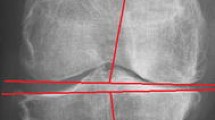Summary
The analysis of causative factors of the pathological process in coxa vara characterized by wearing off of cartilaginous and osseus tissue under pressure forces, points to definite, mutually dependent, mechanical and biological occurences.
Shearing forces which are harmful for enchondral ossification because of morphological changes in coxa vara, are also intensified by disturbed functional changes in the hip. These noxious mechanical factors as well as the biologically diminished tissue resistence are the main causal agents of progressive bone deformation.
The authors attempted, by surgical correction of disturbed mechanical relations in coxa vara, to influence favourably the pathogenic process and to determine the importance of biologic and mechanic causative factors.
The epiphyseal cartilage was placed perpendicular to the direction of the static force by corrective intertrochanteric osteotomies. In spite of surgical correction of ED and CCD angle, there has not always been achieved normalisation of the ossification process, according to postoperative analysis. The conclusion is therefore that in the pathological process in coxa vara, the primarily disturbed biologic potential is also of great importance.
In the evaluation of the X-ray results, the authors used their own method for measurement of the angle between the epiphyseal cartilage and femoral diaphysis axis.
Zusammenfassung
Die Analyse der kausalen Faktoren des pathologischen Prozesses von Coxa vara, der durch Nachlassen des Knorpel- und Knochengewebes den Kräften der Belastung charakterisiert ist, deutet auf ein bestimmtes untereinander abhängiges mechanisches und biologisches Geschehen. Die Kräfte der Scherung, welche wegen der morphologischen Veränderungen bei Coxa vara auf die enchondrale Ossifikation ungünstig einwirken, sind auch durch gestörte funktionelle Veränderungen in der Hüfte potenziert. Diese mechanisch schädigenden Faktoren und biologisch verminderte Widerstandskraft des Gewebes sind die Hauptursachen der progressiven Deformation der Knochen.
Durch operative Normalisation der gestörten mechanischen Verhältnisse trachteten wir bei unserem Material auf den pathogenetischen Prozeß günstig einzuwirken und die Wichtigkeit der biologischen und mechanischen kausalen Faktoren zu bestimmen. Durch korrektive intertrochantere Osteotomien stellten wir den Epiphysenknorpel des Wachstums vertikal zur resultierenden Kraft der Belastung der Hüfte. In den postoperativen Analysen hatten wir in der Regel keine Normalisierung der Ossifikation, und wir schließen daher, daß im pathologischen Prozeß von Coxa vara auch das primär gestörte biologische Potential eine wichtige Rolle spielt.
In der Evaluation des Krankengutes bedienten wir uns unserer eigenen Methode zur Messung der Neigung des Epiphysenknorpels des Wachstums gegenüber der Achse der Diaphyse des Femur.
Similar content being viewed by others
Literatur
Duchenne, G. B.: Physiologie des movements, 1867, par. 321 i 340. Translated and edited by E. B. K. Kaplan. Philadelphia-London: Saunders 1959.
Haraldson, S.: The epiphyseal angle in coxa vara infantum and its relation to results. Acta orthop. scand. 39, 76–81 (1968).
Pauwels, F.: Gesammelte Abhandlungen zur funktionellen Anatomie des Bewegungsapparates. Berlin-Heidelberg-New York: Springer 1965.
Pauwels, F.: Zur Therapie der kindlichen Coxa vara. Z. Orthop. 64, 372–387 (1936).
Trendelenburg, F.: Über den Gang bei angeborener Hüftgelenkluxation. Dtsch. med. Wschr. 2, 21–24 (1895).
Author information
Authors and Affiliations
Rights and permissions
About this article
Cite this article
Ruszkowski, I., Kovačić, S. Biomechanische Analyse gestörter Ossifikation bei Coxa vara und ihre Normalisierung nach korrektiven Osteotomien. Arch orthop Unfall-Chir 74, 338–344 (1973). https://doi.org/10.1007/BF00416257
Received:
Issue Date:
DOI: https://doi.org/10.1007/BF00416257




